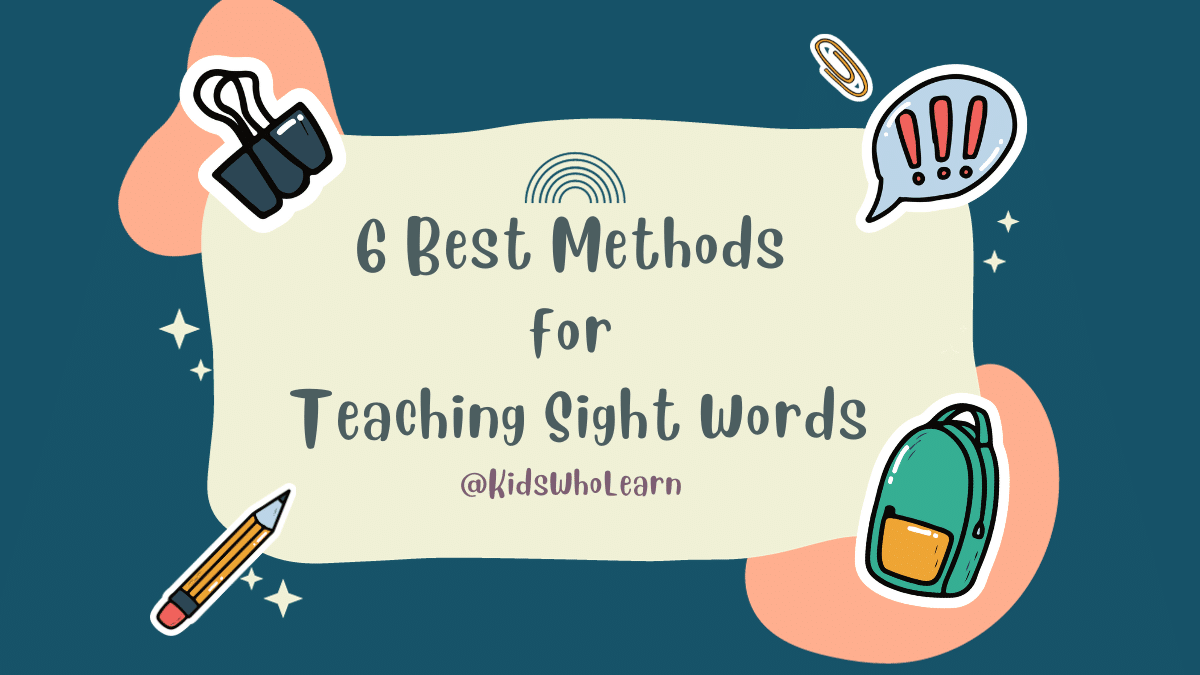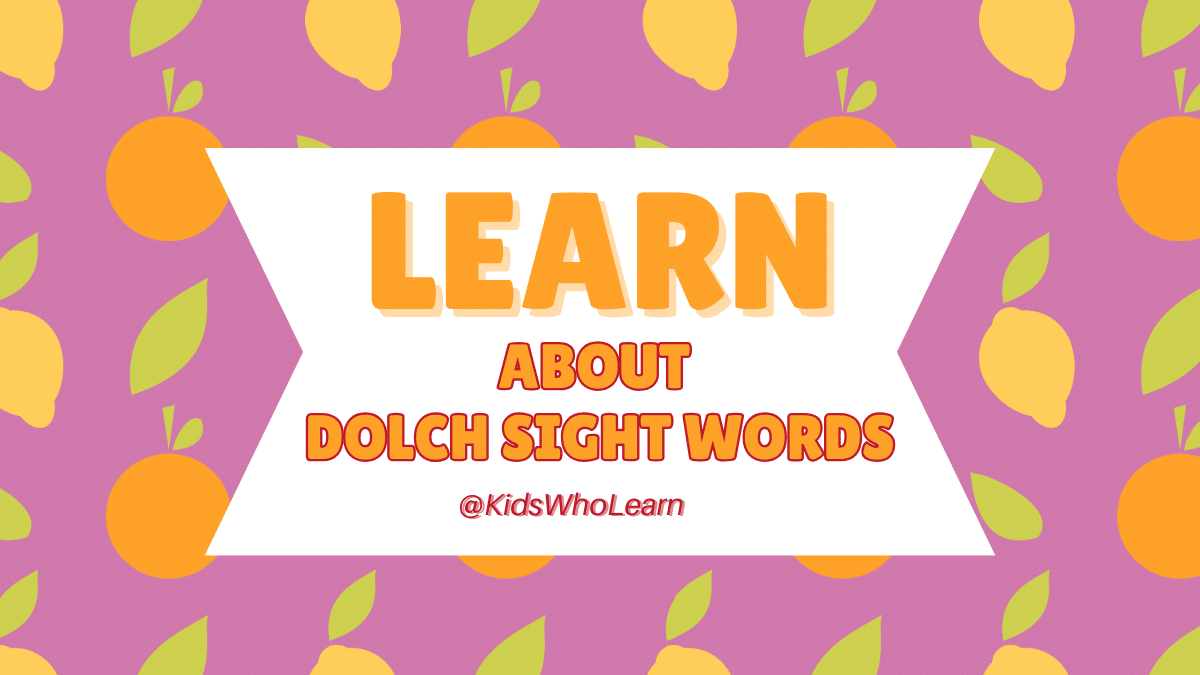
Learning sight words is a critical step in the reading journey, as sight words make up a significant portion of the words that children encounter in their reading materials.
Sight words, also known as high-frequency words, are common words that appear frequently in the English language and cannot be easily sounded out.
Children must be able to recognize and read these words quickly and accurately to achieve reading fluency.
Teaching high-frequency words requires a structured approach, and there are several effective methods to introduce sight words to children, including the use of Fry words, which are a common list of sight words.
Once children have been introduced to new sight words, they must practice reading and writing them to reinforce their recognition and retention. Struggling readers can practice new words through reading sight words and sight word games.
There are several different methods for sight word instruction and how to teach sight words – each with its own strengths and weaknesses. In this article, we will explore six popular techniques for sight word instruction:
- Look-Say Method
- Spell-Reading Method
- Arm-Tapping Method
- Air Writing Method
- Table Writing Method
- Corrections Procedure
By understanding the strengths and weaknesses of each technique, parents and teachers can choose the best approach for their child or students and help them achieve reading success.
In this article, we will explore different techniques and strategies for teaching sight words, introducing new sight words, and helping children learn to read and write sight words with ease. By following these methods, parents and teachers can help children become confident and successful readers who can navigate any reading material with ease.
How to Teach Sight Words Method #1 – The “Look-Say” Method
What Is the Look-Say Method to Teach Sight Words?
The “look-say” technique, also known as the “see-say” method, is a common technique for teaching sight words to young readers. It involves teaching children to recognize whole words by sight rather than sounding them out phonetically.
How Does the Look-Say Method to Teach Sight Words Work?
Here’s how it works:
- The teacher shows the child a word card with a sight word written on it. The child looks at the word and says it aloud.
- If the child does not know the word, the teacher tells them what it is and has them repeat it.
- The teacher then shows the word again and asks the child to say the word aloud. The teacher repeats this process until the child can recognize and say the word quickly and confidently.
- The teacher then introduces similar sight words, building upon the child’s sight word vocabulary.
What Are the Strengths and Weaknesses of the Look-Say Method to Teach Sight Words?
Strengths of the Look-Say Method to Teach Sight Words:
- It provides a whole-word approach to learning sight words, which can be helpful for students who struggle with phonics.
- Encourages students to recognize words by sight rather than sounding them out.
Weaknesses of the Look-Say Method to Teach Sight Words:
- It may not be as effective for developing phonics skills or learning words that do not follow standard spelling rules.
- Applying to words that students have never seen can be challenging.
While the see-say technique can be effective for teaching sight words, it is essential to note that there are other techniques for teaching sight words, and there may be better techniques for some children. Teachers and parents should use various methods to support children’s learning and find the best approach for each child.
How to Teach Sight Words Method #2 – The Spell-Reading Method
What is the Spell Reading Method to Teach Sight Words?
The Spell Reading technique is a method for teaching sight words that emphasizes phonics and decoding skills. It involves breaking words down into their individual letter sounds and teaching students to recognize and decode those letter sounds to read the whole word.
How Does the Spell Reading Method to Teach Sight Words Work?
Here’s how it works:
- The teacher shows the student a word card with a sight word written on it. The student sounds out each individual letter or sound in the word from left to right.
- Once the student has sounded out the word, the teacher asks them to blend the sounds together to form the whole word.
- The teacher then asks the student to say the word aloud and check if it matches the written word on the card.
- The teacher then introduces similar sight words, building upon the student’s phonics and decoding skills.
The Spell Reading technique is based on the idea that students will be better able to read unfamiliar words if they have a strong foundation in phonics and decoding skills. By breaking words down into their individual sounds, students can understand the relationship between letters and sounds and apply this knowledge to new words they encounter.
What Are the Strengths and Weaknesses of the Spell Reading Method for to Teach Sight Words:
Strengths of the Spell Reading Method to Teach Sight Words:
- It helps students understand the relationship between letters and sounds, which can help develop phonics skills.
- Encourages students to sound out words and read them phonetically.
Weaknesses of the Spell Reading Method to Teach Sight Words:
- It may not be as effective for sight words that do not follow standard phonetic rules (such as “the” or “said”).
- It can be time-consuming and may not be feasible for larger groups of students.
While the Spell Reading technique can be effective for teaching sight words, it is essential to note that there are other techniques for teaching sight words, and there may be better techniques for some children. Teachers and parents should use various methods to support children’s learning and find the best approach for each child.
How to Teach Sight Words Method #3 – The Arm-Tapping Method
What Is the Arm-Tapping Method to Teach Sight Words?
The Arm Tapping method is a kinesthetic approach to teaching sight words that involve tapping the arm to represent each syllable or sound in a word.
How Does the Arm-Tapping Method to Teach Sight Words Work?
Here’s how it works:
- The teacher shows the student a word card with a sight word written on it.
- The teacher says the word aloud while tapping the student’s arm simultaneously, tapping once for each syllable or sound in the word.
- The student repeats the word while tapping their own arm in the same way.
- The teacher and student repeat this process several times, gradually increasing the tapping speed to build fluency.
- Once the student has mastered the sight word, the teacher introduces additional sight words using the same arm-tapping technique.
The Arm Tapping method is based on the idea that adding a physical movement to the reading process can help reinforce learning and make it more memorable for students. By tapping the arm to represent each syllable or sound in a word, students can understand the relationship between the sounds in the word and the written word itself.
What Are the Strengths and Weaknesses of the Arm Tapping Method to Teach Sight Words?
Strengths of the Arm Tapping Method to Teach Sight Words:
- It provides a physical and kinesthetic approach to learning sight words, which can be helpful for students who learn best through movement and physical activity.
- Encourages students to use multiple senses (touch and sound) while learning.
Weaknesses of the Arm Tapping Method to Teach Sight Words:
- It may be distracting or disruptive in a classroom setting.
- It may be less effective for students with motor skills or coordination difficulties.
While the Arm Tapping method can be effective for teaching sight words, it is essential to note that it is not the only technique for teaching sight words, and it may not be the best technique for every child. Teachers and parents should use various methods to support children’s learning and find the best approach for each child.
How to Teach Sight Words Method #4 – The Air-Writing Method
What Is the Air Writing Method to Teach Sight Words?
The Air Writing method is a kinesthetic approach to teaching sight words that involve students writing sight words in the air with their fingers.
How Does the Air Writing Method to Teach Sight Words Work?
Here’s how it works:
- The teacher shows the student a word card with a sight word written on it.
- The teacher says the word aloud while the student traces it in the air with their finger, following the letters and spelling it out loud.
- The student repeats the process, tracing the word in the air with their finger while saying it aloud.
- The teacher and student repeat this process several times, gradually increasing the tracing speed to build fluency.
- Once the student has mastered the sight word, the teacher introduces additional sight words using the same air-writing technique.
The Air Writing method is based on the idea that adding a physical movement to the reading process can help reinforce learning and make it more memorable for students. By tracing the word in the air with their finger, students can see and feel the shape of the word, which can help them learn sight words more easily.
What Are the Strengths and Weaknesses of the Air-Writing Method to Teach Sight Words?
Strengths of the Air-Writing Method to Teach Sight Words:
- It provides a fun and engaging way for students to practice spelling and recognizing sight words.
- Encourages students to use their imagination and creativity while learning.
Weaknesses of the Air Writing Method to Teach Sight Words:
- It may be less effective for students who need more structure and guidance.
- Monitoring and assessing progress can be challenging, as there is no physical learning record.
How to Teach Sight Words Method #5 – The Table-Writing Method
What Is the Table Writing Method to Teach Sight Words?
The Table Writing method is a visual and tactile approach to teaching sight words that involve students writing words on a table or other flat surfaces.
How Does the Table Writing Method to Teach Sight Words Work?
Here’s how it works:
- The teacher uses a marker or other writing tool to write a sight word on the table or other flat surfaces.
- The teacher says the word aloud while the students trace the word’s letters on the table with their finger, following the letters and spelling them out loud.
- The student repeats the process, tracing the word on the table while saying the word out loud.
- The teacher and student repeat this process several times, gradually increasing the tracing speed to build fluency.
- Once the student has mastered the sight word, the teacher introduces additional sight words using the same table-writing technique.
The Table Writing method is based on the idea that using a tactile approach can help reinforce learning and make it more memorable for students. By tracing the word on the table with their finger, students can see and feel the shape of the word, which can help them remember it more easily.
What Are the Strengths and Weaknesses of the Table Writing Method to Teach Sight Words?
Strengths of the Table Writing Method to Teach Sight Words:
- It provides a tactile and visual approach to learning sight words, which can be helpful for students who learn best through hands-on activities.
- It helps students learn the shape and structure of words, making it easier to recognize and spell sight words.
Weaknesses of the Table Writing Method to Teach Sight Words:
- It may be less effective for students who do not learn well through tactile or visual methods.
- It can be time-consuming and may not be feasible for larger groups of students.
How to Teach Sight Words Method #6 – The Corrections Procedure
What is the Corrections Procedure to Teach Sight Words?
The Corrections Procedure is a technique for teaching sight words that involve correcting students’ mistakes as they read a list of words.
How Does the Corrections Procedure to Teach Sight Words Work?
Here’s how it works:
- The teacher creates a list of sight words for the student to read.
- The student reads the words aloud, and the teacher listens carefully for mistakes.
- When the student makes a mistake, the teacher immediately corrects them by saying the word correctly and having the student repeat it.
- The teacher and student repeat the corrected word several times to reinforce the correct pronunciation and spelling.
- The teacher continues through the list, correcting any other mistakes as they arise.
The Corrections Procedure is based on the idea that correcting mistakes immediately can help reinforce the correct spelling and pronunciation of sight words. By fixing errors as they occur, students can avoid developing bad habits and can build a strong foundation of proper spelling and pronunciation.
What Are the Strengths and Weaknesses of the Table Writing Method to Teach Sight Words?
Strengths of the Corrections Procedure to Teach Sight Words:
- Corrects mistakes immediately, which can help reinforce the correct spelling and pronunciation of sight words.
- Provides immediate feedback to the student, which can help them learn more quickly.
Weaknesses of the Corrections Procedure to Teach Sight Words:
- Constant correction can discourage some students and may lead to frustration or a lack of confidence.
- There may be better approaches for students who are easily distracted or overwhelmed.
Conclusion:
In conclusion, there are many different techniques for teaching sight words, each with its own unique strengths and weaknesses.
The corrections procedure can be helpful for immediate feedback and reinforcement, while the table writing method can provide a tactile and visual approach to learning.
The air writing method can be engaging and creative, and the arm-tapping method can provide a physical and kinesthetic approach.
The spell-reading method can help develop phonics skills, and the look-say method can be a useful whole-word approach.
By understanding the strengths and weaknesses of each technique, parents and teachers can choose the best approach for their child or students and help them achieve reading success.
Whether it’s through a combination of these techniques or a personalized approach, the key is to make learning sight words fun and engaging while providing the necessary structure and guidance for success.
With patience, perseverance, and various practical techniques, children can become confident and successful readers for life.







